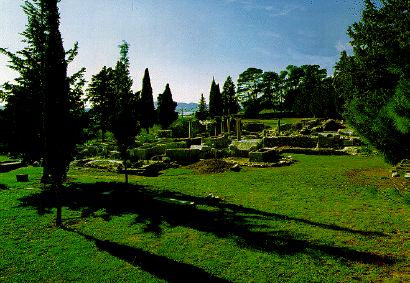

Salona was a stronghold and a harbour of the Illyrian Delmati which quite early came into the sphere of influence of the Greeks on the Adriatic. Julius Caesar, who was then the governor of Illyricum gave it the rank of a colony (Colonia Martia Julia Salona) - the center of the province of Illyricum and afterwards of the province of Dalmatia. It developed into a cosmopolitan centre of the Adriatic. The high point of its expansion was during the time of Diocletian when it received the honorary title Valeria, which as a family name belonged to the emperor himself. In the period between the IVth and Vlth centuries Salona became an important centre of Christianity. It fell before the onslaught of the Avars and Slavs around the year 641.
The Illyrian core of the city has been discovered recently. A segment of the city walls with a monumental gate (Porta Caesarea) and towers has been preserved from the first Roman phase. The city quickly spread to the East and West and in the IInd century was enclosed with new walls. The Forum was located in the centre of the city near the sea. In the Ist century a theatre and baths were built next to it. A much better preserved complex of baths was found to the East of the later bishop's basilica in the eastern part of the city. Here we also find the sumptuous Villa Urbana known for its mosaics with depictions of Apollo Orpheus Triton (now kept in the Split Archaeological Museum). Within the fortification system in the north-western corner of the city an amphitheatre was raised in the IInd century. The great city necropolis containing some of the most famous sarchophagi in Solin stood alongside the road that led to Tragurium (necropolis in horto Metrodori).
Christian grave yards with basilicas grew on pagan necropoles. The oldest basilica is the one known as "the basilica of the ve martyrs" on Kapljuc next the city walls. The most complex is the one on Manastirine, the starting point of most walks through Solin. The most interesting in view of new architectural solutions, is the Early Christian necropolis on Marusinac. Two large basilicas (geminae) stood in the new Christian centre of Salona. The northern one had three naves, a baptistry and the episcopal palace that was organically joined to it. During the last phase the southern one received a cross-like ground plan. Both were connected with a narthex. It is important to mention that eight additional basilicas have been explored within the city perimeter. Most of the movable monuments from Salona are kept in the Archaeological Museum, in Split which was founded in 1821.
The old Croatian Solin grew alongside the river Jadro to the East of the ruins of the Antique city. The churches built by the Early Medieval Croatian rulers have been thoroughly investigated: St Mary's and St Stephen's churches, the royal mausoleums alongside today's church of Our Lady of the Isle, where the famous table containing queen Jelena's epitaph was found, the church in Gradina (possibly a reused Early Christian edifice) and King Zvonimir's coronation "Hollow church" (Xlth century) built on the foundations of one of the most monumental Early Christian basilicas on the eastern Adriatic coast. The remnants of the Benedictine monastery in Ritince beneath Klis lie a little further from this spot. A number of Old Croatian necropoles have been explored in the surrounding area. The finds are presented in the Museum of Croatian Archaeological Monuments and in the Archaeological Museum in Split.